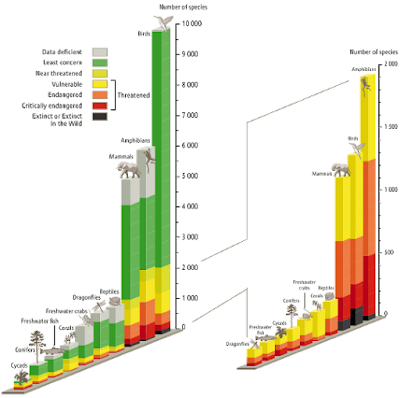Biodiversity refers to the variety of living things in an environment. It is seen in the number of species in an ecosystem or on the entire Earth. Biodiversity gets used as a measure of the health of biological systems, and to see if there is a danger that too many species become extinct.
CAUSES OF THE LOSS OF BIODIVERSITY
The main cause of the loss of biodiversity can be attributed to the influence of human beings on the world’s ecosystem, In fact human beings have deeply altered the environment, and have modified the territory, exploiting the species directly, for example by fishing and hunting, changing the biogeochemical cycles and transferring species from one area to another of the Planet. The threats to biodiversity can be summarized in the following main points:
- Alteration and loss of the habitats
- Introduction of exotic species and genetically modified organisms
- Pollution
- Climate change
- Overexploitation of resources
Why conserve India's biodiversity?
The world needs to act quickly to counter the erosion of species. The task is particularly important for India, one of the 12 mega-biodiversity centers.
May 22 marked the International Day for Biological Diversity. It commemorates the adoption of the Convention on Biological Diversity (CBD) that day in 1992. This year has been declared the International Year of Biodiversity.
The term biodiversity denotes the variability of life forms on earth. It is a vital resource that needs to be assiduously conserved as it holds the key to progress in medicine, agriculture, forestry and other fields.
Globally, 1.4 million life forms have been named and described by science. Biological estimates suggest that the number of species may be 10 times those described so far. Plant and animal species from major families are still being discovered in rain forests. Over 300 new fish species have been described from the Amazon region. Amphibians have recently been reported from the Sathyamangalam forests in Tamil Nadu.
Botanist Alvin Gentry estimates that 15,000-20,000 species of tropical flowering plants are yet to be documented. But then, this diversity is being eroded on an unprecedented scale. During the last 200 million years about 100 species became extinct in each century due to the natural evolutionary process.
At the same time, evolution ushered in new life forms that more than compensated for those that were lost. Today, the extinction rate is approximately 40,000 times higher than this background rate due to human depredations. For the first time an enormous proportion of terrestrial plant species that form the basis of land ecosystems remains threatened. Previous mass extinctions had no palpable effect on terrestrial plants.
But today, one-fifth of all plant species on land face annihilation in the next 20 years. A disappearing plant can take with it 10-30 dependent species such as insects, higher animals and even other plants. According to one estimate, we may already be losing 100 species a day.
•Despite knowing about biodiversity’s importance for a long time, human activity has been causing massive extinctions. As the Environment New Service, reported back in August 1999 (previous link): “the current extinction rate is now approaching 1,000 times the background rate and may climb to 10,000 times the background rate during the next century, if present trends continue [resulting in] a loss that would easily equal those of past extinctions.” (Emphasis added)
•A major report, the Millennium Ecosystem Assessment, released in March 2005 highlighted a substantial and largely irreversible loss in the diversity of life on Earth, with some 10-30% of the mammal, bird and amphibian species threatened with extinction, due to human actions. The World Wide Fund for Nature (WWF) added that Earth is unable to keep up in the struggle to regenerate from the demands we place on it.
At threat of extinction are
•1 out of 8 birds
•1 out of 4 mammals
•1 out of 4 conifers
•1 out of 3 amphibians
•6 out of 7 marine turtles
•75% of genetic diversity of agricultural crops has been lost
•75% of the world’s fisheries are fully or over exploited
•Up to 70% of the world’s known species risk extinction if the global temperatures rise by more than 3.5°C
•1/3rd of reef-building corals around the world are threatened with extinction
•Over 350 million people suffer from severe water scarcity
"The world environmental situation is likely to be further aggravated by the increasingly rapid, large scale global extinction of species. It occurred in the 20th century at a rate that was a thousand times higher than the average rate during the preceding 65 million years. This is likely to destabilize various ecosystems including agricultural systems.…In a slow extinction, various balancing mechanisms can develop. Noone knows what will be the result of this extremely rapid extinction rate. What is known, for sure, is that the world ecological system has been kept in balance through a very complex and multifaceted interaction between a huge number of species. This rapid extinction is therefore likely to precipitate collapses of ecosystems at a global scale. This is predicted to create large-scale agricultural problems, threatening food supplies to hundreds of millions of people. This ecological prediction does not take into consideration the effects of global warming which will further aggravate the situation.Industrialized fishing has contributed importantly to mass extinction due to repeatedly failed attempts at limiting the fishing.A new global study concludes that 90 percent of all large fishes have disappeared from the world’s oceans in the past half century, the devastating result of industrial fishing. The study, which took 10 years to complete and was published in the international journal Nature, paints a grim picture of the Earth’s current populations of such species as sharks, swordfish, tuna and marlin.
…According to the most comprehensive study done so far in this field, over a million species will be lost in the coming 50 years. The most important cause was found to be climate change"



